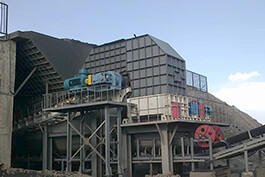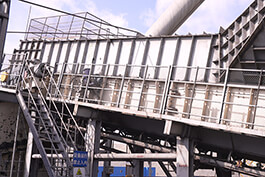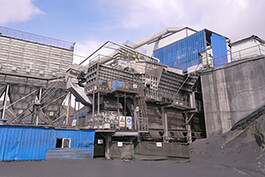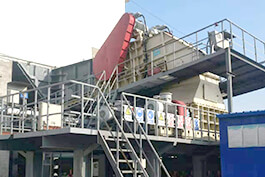The crushing principle of Mineral Sizers
Mineral Sizers adopts a parallel arrangement structure design of double roller shafts. Through the toothed structure on the surface of the rotating crushing rollers, it exerts efficient compressive force and shear force on the incoming materials, thereby achieving the crushing process of the materials.
Compressive force
The serrated structure on the roller surface will compress the materials firmly as they enter the space between the two rollers. The compressive force progressively rises as the materials keep coming in and the rollers turn.When this stress exceeds the compressive strength limit of the materials, the materials will break, thus achieving the crushing effect.
Shear force
The tooth profile on the roller surface is distributed in a spiral along the axial direction. Because of this design, the material can be subjected to both compressive force and the shearing action of the teeth tips while rotating. This shearing force can efficiently encourage the dissociation of materials and improve crushing efficiency, particularly for multilayer or brittle materials.
Impact crushing
Mineral Sizers' high-speed rotating crushing rollers can apply an immediate impact force on the material in addition to compressive and shearing forces. When crushing brittle materials, this impact force works especially well since it may quickly shatter the material into the appropriate size and increase crushing efficiency.
Crushing and Screening
Three-stage Crushing
The big chunks of material are initially struck by the toothed roller's teeth during rotation, which results in impact, shearing, and ripping. If the material fragments can be held by the tooth teeth, they will enter the second stage of crushing; otherwise, the tooth teeth will slide along the surface of the material, and the helically arranged tooth teeth will force the material to flip, waiting for the action of the next pair of tooth teeth.
From the moment the material is held by the tooth teeth, until the first pair of tooth teeth detaches from the material. During this stage, the accommodating space between the two tooth teeth gradually decreases, and the material is compressed and sheared. The crushed material is squeezed out from the gap on the tooth side.
When the first pair of tooth teeth begins to detach, a large amount of crushed material leaks out, and some large particles will be blocked by the crushing rods. When the tooth teeth move near the crushing rods, they act together with the crushing rods, splitting the large pieces of material and squeezing them out. At this point, the crushing process of the pair of tooth teeth ends.
.jpg)
Rotary Screening
Throughout the crushing roller's rotation, the material is continuously screened by the toothed structure. Particles bigger than the discharge opening size are held in the crushing chamber and continue to undergo crushing treatment, while particles smaller than the discharge opening size can pass straight through the crushing roller thanks to this screening effect.
By precisely adjusting the roller spacing and tooth shape parameters, precise control of the product particle size distribution can be achieved. This control capability makes it possible to dynamically modify the crushing process in accordance with actual needs, thereby satisfying the particular material particle size requirements of various application scenarios. Additionally, this exact control lowers the likelihood of over-crushing, increasing the material's rate of use.
The rotary screening effect not only efficiently lowers the energy consumption per unit by reducing over-crushing, but it also increases crushing efficiency, making the crushing process as a whole more efficient and energy-efficient. Compared with the combination of traditional jaw crushers and cone crushers, the rotary screening crushing roller of Mineral sizer has more obvious energy efficiency advantages. It can significantly reduce energy consumption while ensuring the crushing effect.
Analysis of Factors Causing Overload and Inefficient Discharge
Overload operation
Material properties
The material characteristics have a significant impact on the crushing process. Specifically, high-humidity materials are prone to adhesion within the crushing chamber, which not only hinders the normal flow of materials but also gradually accumulates to form blockages, ultimately leading to a significant decline in the processing capacity of the mineral sizer and affecting production efficiency. However, because of their hard physical characteristics, high-hardness materials—particularly those with a Mohs hardness more than 6—need more crushing power to be broken during the crushing process. This shortens the equipment's service life by increasing energy consumption and perhaps causing more wear on the mineral sizer's components.
Parameter mismatch
The necessary crushing force during the crushing operation will increase significantly if the space between the rollers is adjusted too narrowly. This increased crushing force often exceeds the rated power range that the motor can withstand. In this case, the motor, in order to protect itself from damage due to overload, will automatically trigger the overload protection mechanism, thereby stopping operation to avoid further damage.
Uneven feeding
The concentrated feeding method causes the accumulation of materials in a specific area to increase sharply. This uneven material distribution directly leads to the load in that area far exceeding the originally designed maximum load capacity. Due to the excessive concentration of the load, the toothed structure, under the action of huge pressure and friction, rapidly wears out its surface material, with the wear rate significantly accelerating, ultimately resulting in a sharp decline in the overall performance of the toothed structure, seriously affecting the normal operation and service life of the mineral sizer.
Causes of poor discharge
Blockage of discharge port
When the proportion of fine-grained materials exceeds 35%, these fine particles are prone to form a bridge phenomenon at the discharge port. This is due to the relatively strong adhesive force between fine-grained materials, which causes them to gravitate toward and stick to one another during flow, creating a structure resembling a bridge. This bridge phenomena will significantly reduce the discharge speed and impede the flow of materials. The accumulation of materials at the discharge port can harm the mineral sizer in addition to reducing production efficiency. Therefore, in order to ensure that fine-grained materials can be discharged smoothly, appropriate steps must be taken to prevent the formation of this bridge phenomenon. These steps include modifying the materials' moisture content and adding dispersants.
Gear wear
When the wear degree of the gear height exceeds 40% of its original size, the efficiency of crushing will significantly decrease. This not only affects production efficiency but also causes instability in the operation of the mineral sizer. At the same time, severely worn gears will significantly increase the risk of material jamming during crushing, which not only further reduces the crushing effect but may also cause faults in the mineral sizer, increasing maintenance costs and downtime, and having a negative impact on the entire production process.
Hydraulic system failure
When the overload protection device detects that the current exceeds the safety threshold, it does not immediately activate the protection mechanism but instead there is a certain response delay time. This keeps the system from accidentally setting off the security device when the current changes for a short time, and it also keeps the system running smoothly. If the overload situation stays on for too long, the overload protection device will start the safety mechanism to keep the mineral sizer from getting damaged by the overload. At this time, the protection device will cut off the power supply, causing the equipment to stop working, thereby avoiding possible safety accidents and equipment damage.
Conclusion
For the overload issue of Mineral Sizers, a systematic investigation needs to be conducted from multiple dimensions such as material characteristics, equipment parameters, and feeding methods. At the same time, a warning mechanism based on equipment operation data should be established to achieve the transformation from passive maintenance to proactive prevention.


.jpg)
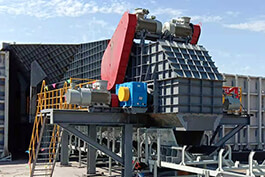
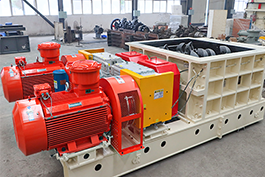
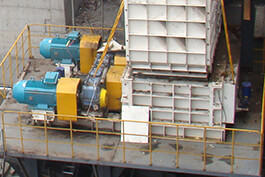
.jpg)
